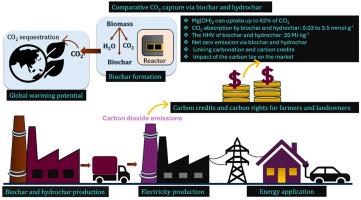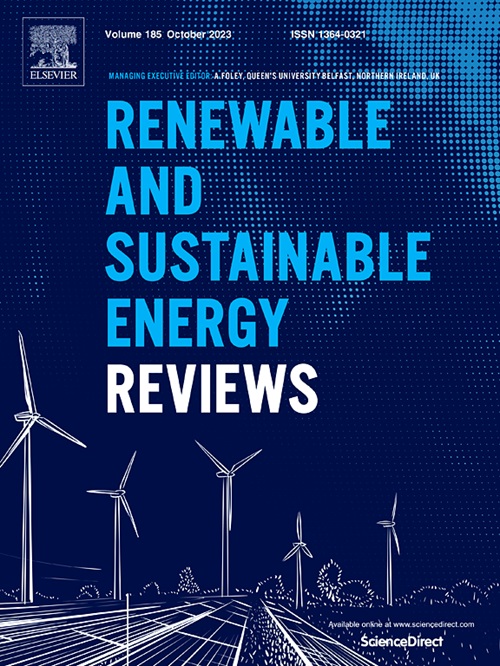通过生物质热解和热液碳化获得碳信用额:综述
IF 16.3
1区 工程技术
Q1 ENERGY & FUELS
引用次数: 0
摘要
不同的添加剂可在生物质热解过程中捕获二氧化碳(CO2)。生物炭和水炭有可能封存二氧化碳。有关通过生物炭和水炭封存二氧化碳及其与碳信用额关系的比较研究尚不充分。本研究旨在探索在生物质干馏和水热碳化(HTC)过程中使用添加剂(氢氧化镁、Mg(OH)2 和 Mg(OH)3)固存二氧化碳的情况:Mg(OH)2)和氧化钙(CaOCaO),对生物炭和水炭的二氧化碳封存进行比较分析,分析两者的能量增量,并确定与这些过程相关的碳信用和碳权利的前景。在烘干过程中,Mg(OH)2 最多可捕获 62% 的二氧化碳,而在水炭生产过程中不需要添加剂,因为二氧化碳不会释放出来。生物炭和水炭对二氧化碳的吸收量从 0.03 到 3.5 mmol g-1 不等。焦化生物炭的含碳量在 50 至 70 wt% 之间,而水炭的含碳量在 48 至 70 wt% 之间,类似于褐煤。生物炭、水炭和褐煤的较高热值(HHV)也相当,接近 25 兆焦耳/千克-1。生物炭发电的全球升温潜能值(GWP)低于煤炭发电,而水煤炭发电的全球升温潜能值较高。由于其干燥和活化方法,水煤炭生产的效率较低。生物质干馏和热碳化可以通过减少排放获得碳信用额度,并通过加强生物质生产土地的碳封存与碳权利挂钩。未来有关生物质热解炭和氢化炭衍生水炭的碳信用额和碳权利的研究方向可以集中在优化生产工艺、改进转化技术和最大限度地固碳上。本文章由计算机程序翻译,如有差异,请以英文原文为准。

Achieving carbon credits through biomass torrefaction and hydrothermal carbonization: A review
Different additives can capture carbon dioxide (CO2) during biomass torrefaction. Biochar and hydrochar can potentially sequester CO2. A comparative review of CO2 sequestration via biochar and hydrochar and its relationship with carbon credits is inadequate. This research aims to explore CO2 sequestration during biomass torrefaction and hydrothermal carbonization (HTC) with additives (magnesium hydroxide: Mg(OH)2, and calcium oxide: CaO), conduct a comparative analysis of CO2 sequestration by biochar and hydrochar, analyze the energy increment in both, and determine the prospects of carbon credit and carbon rights related to these processes. During torrefaction, Mg(OH)2 captures up to 62 % of CO2, while no additives are needed in hydrochar production since CO2 is not released. CO2 absorption by biochar and hydrochar ranges from 0.03 to 3.5 mmol g−1. Torrefied biochar exhibits varying carbon contents between 50 and 70 wt%, while the ranges in hydrochar are 48–70 wt%, resembling lignite. The higher heating values (HHV) of biochar, hydrochar, and lignite are also comparable, nearly 25 MJ kg−1. Biochar-based electricity production's global warming potential (GWP) is lower than coal-based production, while hydrochar-based production has a higher GWP. Hydrochar production is less efficient due to its drying and activation methods. Biomass torrefaction and HTC can earn carbon credits by reducing emissions and are tied to carbon rights through enhanced carbon sequestration on biomass-producing land. Future research directions in carbon credits and carbon rights for torrefied biochar and HTC-derived hydrochar can focus on optimizing production processes, refining conversion technologies, and maximizing carbon sequestration.
求助全文
通过发布文献求助,成功后即可免费获取论文全文。
去求助
来源期刊

Renewable and Sustainable Energy Reviews
工程技术-能源与燃料
CiteScore
31.20
自引率
5.70%
发文量
1055
审稿时长
62 days
期刊介绍:
The mission of Renewable and Sustainable Energy Reviews is to disseminate the most compelling and pertinent critical insights in renewable and sustainable energy, fostering collaboration among the research community, private sector, and policy and decision makers. The journal aims to exchange challenges, solutions, innovative concepts, and technologies, contributing to sustainable development, the transition to a low-carbon future, and the attainment of emissions targets outlined by the United Nations Framework Convention on Climate Change.
Renewable and Sustainable Energy Reviews publishes a diverse range of content, including review papers, original research, case studies, and analyses of new technologies, all featuring a substantial review component such as critique, comparison, or analysis. Introducing a distinctive paper type, Expert Insights, the journal presents commissioned mini-reviews authored by field leaders, addressing topics of significant interest. Case studies undergo consideration only if they showcase the work's applicability to other regions or contribute valuable insights to the broader field of renewable and sustainable energy. Notably, a bibliographic or literature review lacking critical analysis is deemed unsuitable for publication.
 求助内容:
求助内容: 应助结果提醒方式:
应助结果提醒方式:


